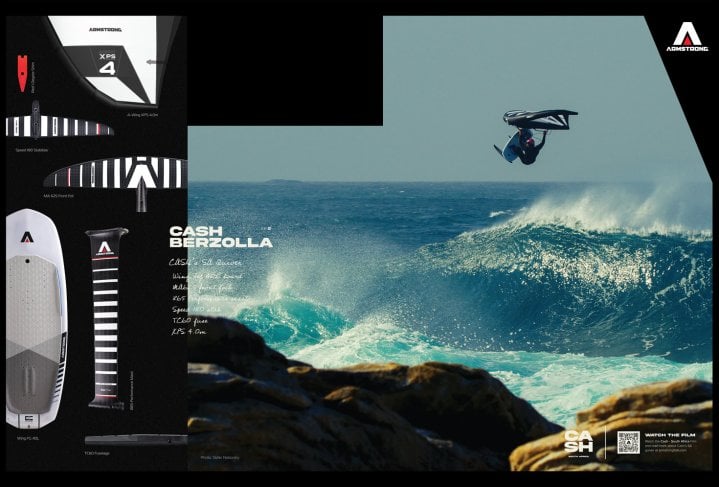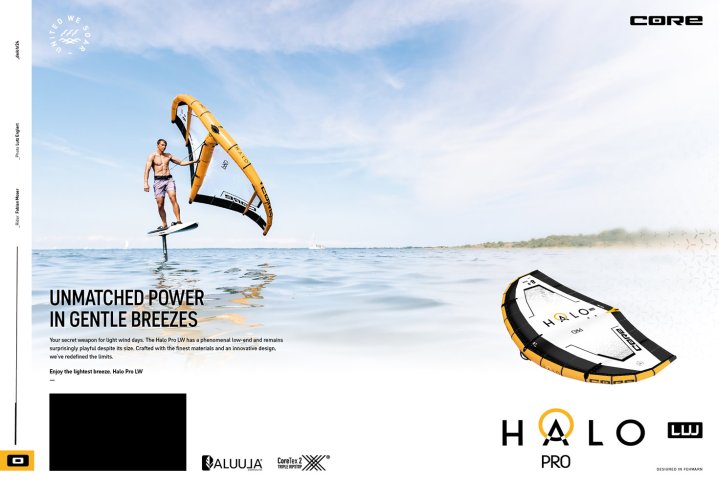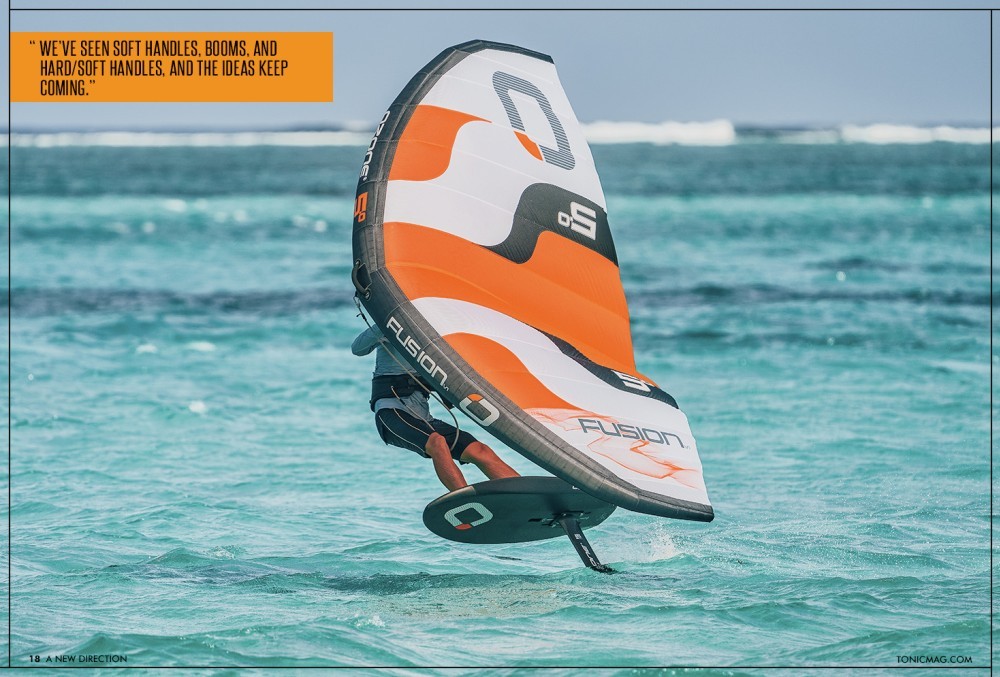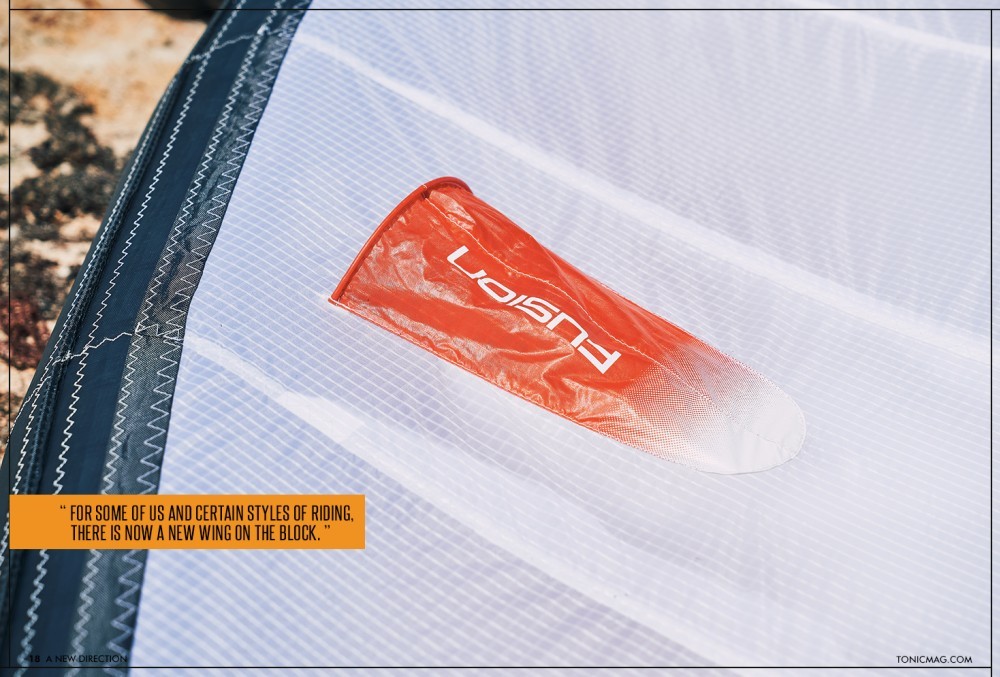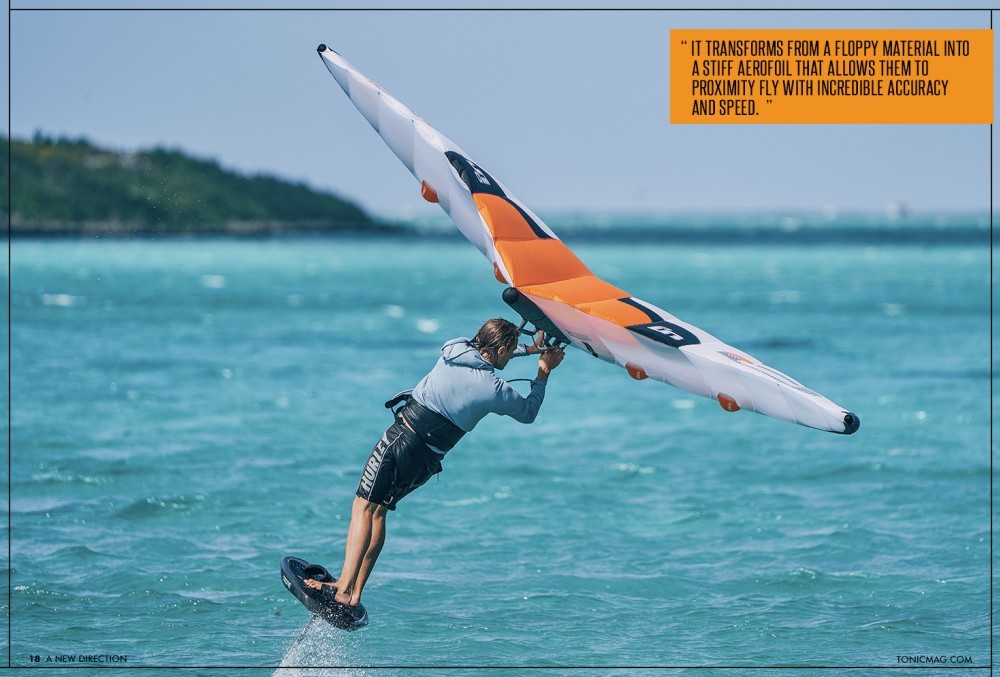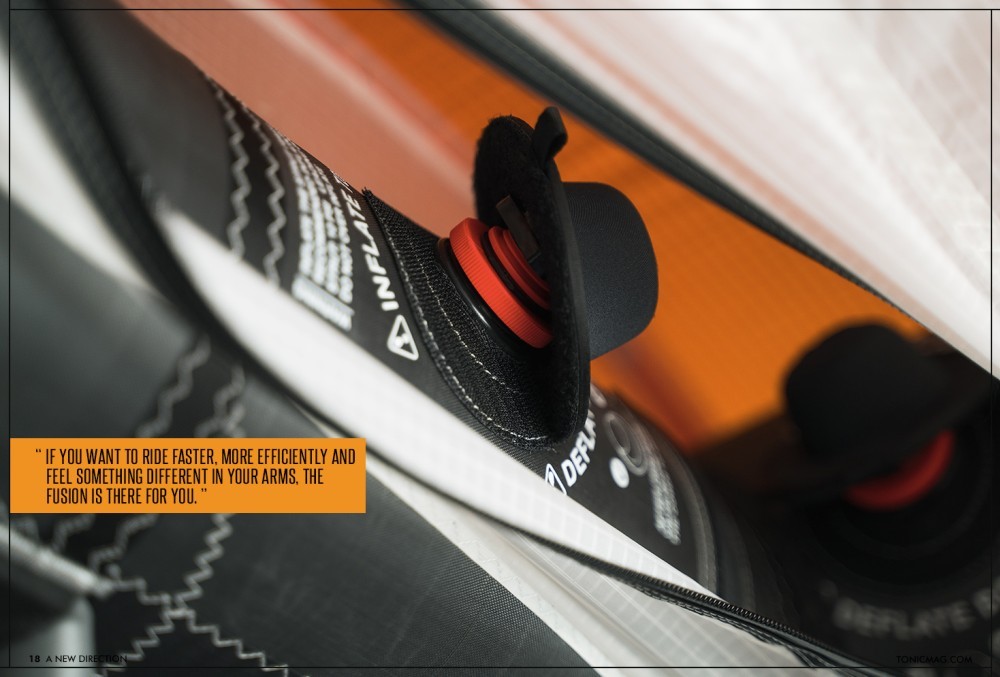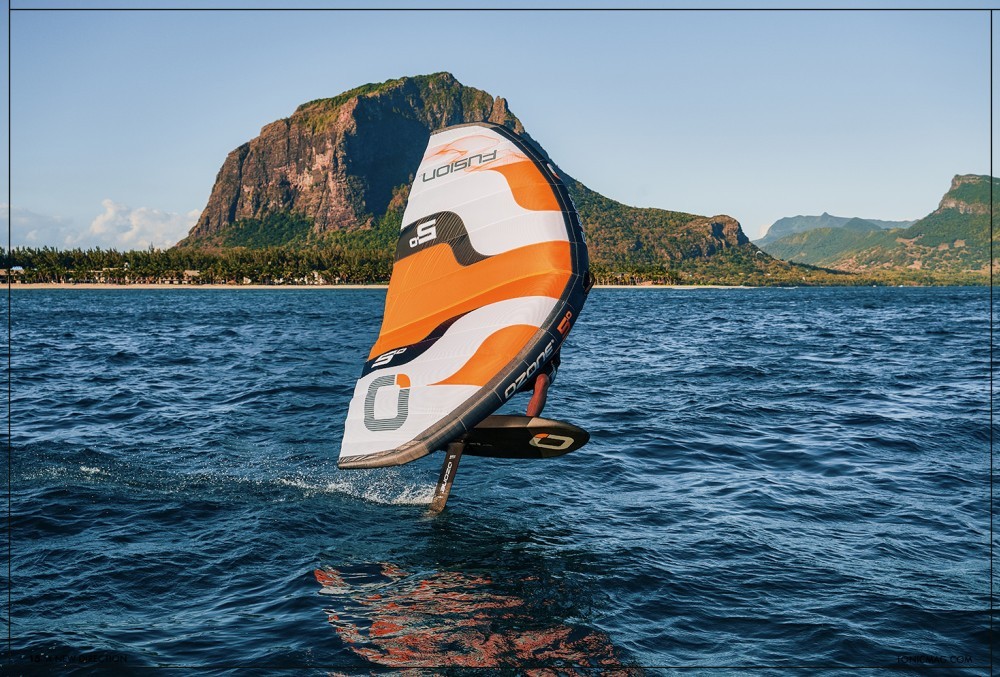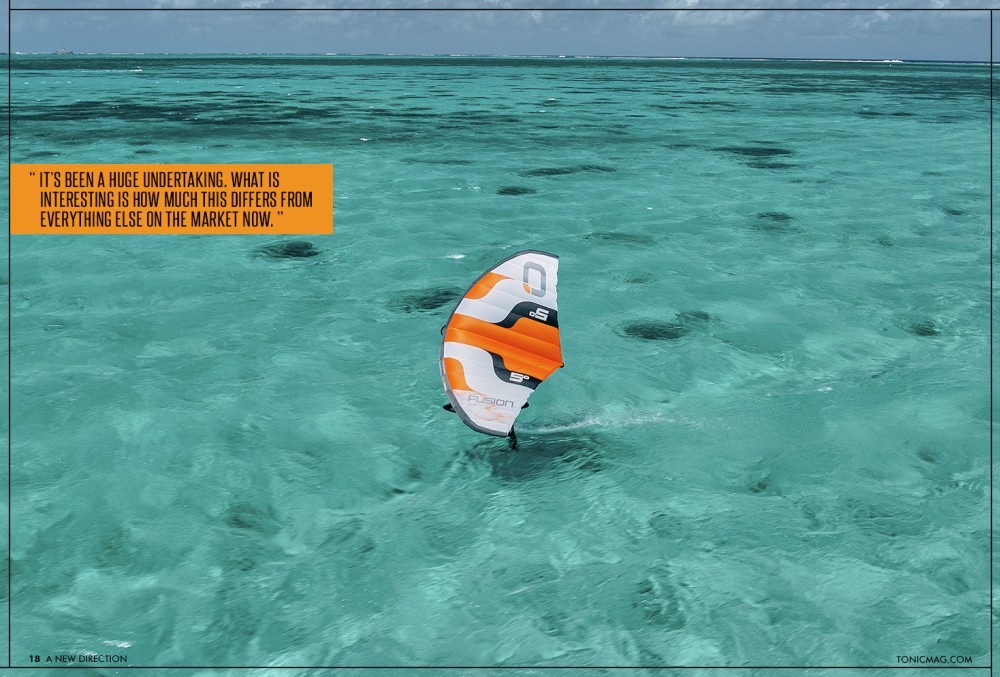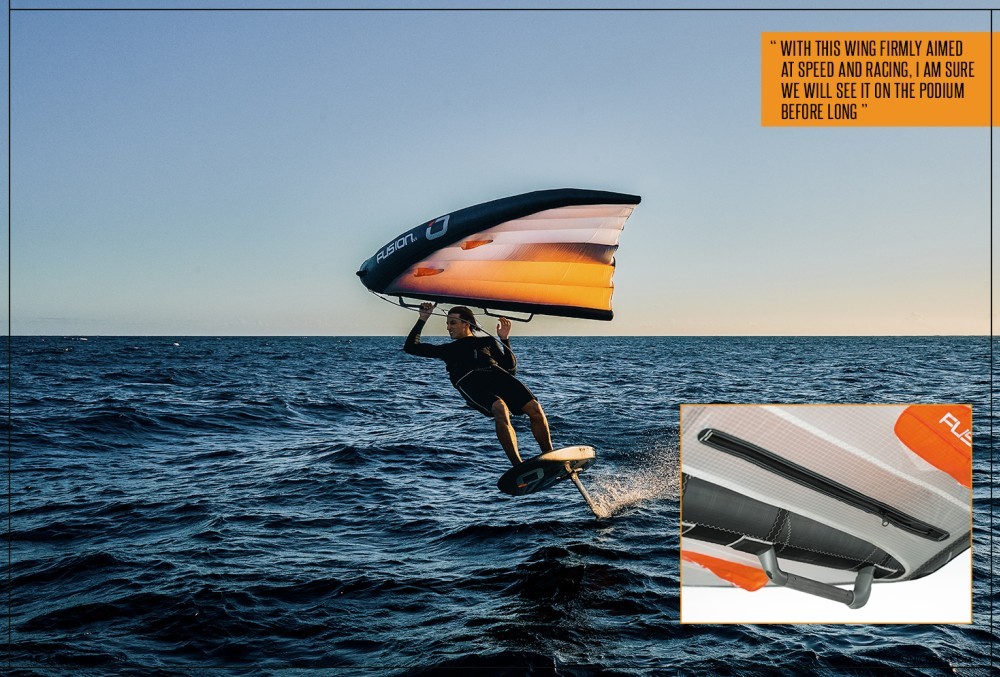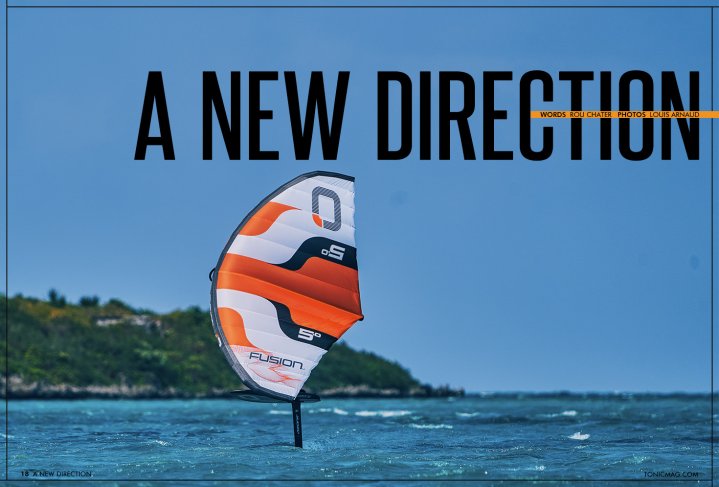
A New Direction
Issue 18 / Tue 21st Nov, 2023
Ozone has just released its latest new wing, the Fusion, which is expected to revolutionise the industry. After years of development and collaboration with the Ozone design team, the Fusion is the first ever double-surfaced ram-air design to hit the market. Rou Chater shares all the details on the brand-new wing in this exclusive feature!
Innovation in the wing industry has been thick and fast; if you look back to the first Naish Wingsurfer design, which arguably was the granddad of them all commercially, it looks different to the wings we use today. It’s even more stark, considering the wing is just four years old.
In a tiny amount of time, our sport has gone from one wing doing it all to multiple sizes, shapes, designs and materials being used. We’ve seen soft handles, booms, and hard/soft handles, and the ideas keep coming. The goal in the industry has always been to create stiffer, more aerodynamic wings. The issue is that to make a wing stiffer, you need a thicker leading edge, and that creates more drag. As ever, we’ve reached a compromised state where the limits in material stiffness hold us back.
You may have noticed something different on our cover and phone screen lately. Ozone, one of the leading brands in the business, has launched the culmination of five years of hard work and the marriage of their vast knowledge of kite, wing, paraglider and wingsuit design. It’s that later one we want to focus on, too, as that is where a fresh influence on winging has had a big impact.
For those who haven’t seen the PR or watched the video, The Fusion is the first truly double-surfaced ram air design on the market. What makes this special, and why do we need it? Well, in truth, not all of us will need it, but don’t let that stop you from reading on. Just like the car industry needs Formula 1, we also need innovation at the top tier of our sport so it trickles down and improves performance for everyone.
When you look at a single-surface wing design, there are obvious flaws. To hold the shape, the leading edge and centre strut need to be fairly substantial; we can’t use bridles like they do on kites to keep a wing profile shape. Once the wind hits it, that simple frame needs all the stiffness. That is a very tall order indeed. Have you ever noticed excess flapping when you get overpowered? That’s the frame distorting and loosening the tension on the canopy, which then flaps.
That creates drag, lots of drag, and it makes the wing hard to handle. Going back a step, though just the inherent shape of the wing before the wind hits it is seriously lacking in aerodynamics, but it’s the nature of our sport and something we have to put up with. As you read on, you’ll realise in many applications, we’ll still be putting up with it too, but for some of us and certain styles of riding, there is now a new wing on the block.
The concept is rather simple: anyone who used to windsurf will remember the invention of the camber inducer. This revolutionised windsurfing sail performance by forcing aerodynamic shape and reducing drag dramatically. Essentially, that’s what’s been achieved on the Fusion; having a double surface over 100% of the wing surface and a ram air design drastically reduces the drag associated with a single surface wing.
Remember those wingsuits, though? That’s where the clever bit comes in… When wingsuit flyers jump off a cliff, building or out of a plane, the suit is just a baggy mess. But as air fills the suit (ram air), it creates pressure inside, which forces the double surfaces into a wing-like shape. The more air hitting the suit, the more the pressure builds and the more solid it becomes, and it transforms from a floppy material into a stiff aerofoil that allows them to proximity fly with incredible accuracy and speed. Here lies the magic of the Fusion; it’s not just about reducing drag and making a smoother aerofoil, which it does with aplomb; it’s about creating a stiffer, more solid airframe. The faster you go, the stronger the wind is, the more powered you are, the more pressure builds up inside the wing, and the stiffer and more solid the airframe becomes.
Let that sink in for a minute; it was a real Eureka moment for me. Usually, the faster I go, the windier it gets, the more my wing deforms, bags, flaps, and becomes a handful. With the Fusion, it’s the opposite. It gets more solid, flaps less, and becomes more stable in your hands…
Before you start rushing to the store with your credit card, there are some limitations here. Due to the nature of the way the wing works, it’s not for everyone. Your rank beginners will never get it moving fast enough to feel the benefits. This is designed with racing and maximum speed in mind. Ozone themselves say that the hugely popular Flux is the answer for most people. However, if you want to ride faster, more efficiently and feel something different in your arms, the Fusion is there for you. Best suited to intermediate and advanced riders, it gets better the faster you go, so riding smaller, 400-500cm from wings becomes achievable and where the wing can really shine.
What are the downsides? It’s a little different to ride; you can’t pump it like your standard wing, and it’s better to let power develop with good wind and shorter pumps with a front-hand bias. It also feels quite different to fly and will take a few sessions at least to get used to.
Furthermore, the nature of the double surface design doesn’t lend itself to wave riding. While the air intakes have been designed to reduce water ingress, and there are water outlets on the trailing edge and near the strut tip, should you get water in? If you give it a serious swamping in the shoredump or ditch it through a bomb set, it won’t be as easy to recover as a single-surface wing. Ozone is still pushing the excellent Flux towards the wave heads, but the new Fusion offers something totally different for the riders looking to go fast and go far…
Another question we’ve been asked is whether it can be repaired. We all know how taxing this sport is on our gear; launching on a big day in the waves is often fifty-fifty as to whether you come back smiling or have to detour past your favourite repair shop. This is another reason the wing is aimed at the more advanced riders and less at the wave heads. It can be repaired, but it’s a little different to a standard wing and, in some cases, perhaps a little more time-consuming to fix. The leading edge closing seam is on the outside, so it can easily be accessed for repairs here. There are zips allowing for bladder access should they get a puncture or need replacing, and the double surfaces can be repaired, too; if you cause serious damage to the internal ribs, these can be accessed and repaired, but as you can imagine, it’s a little more intricate than stitching a new panel on a single surface wing…
It's taken five years to develop, and with world champion paragliders, professional wingsuit flyers on the program, and the kite and wing division, it’s been a huge undertaking. What is interesting is how much this differs from everything else on the market now. While we expect to see some double-surface wings hitting the market, this ram air concept, taking a nod from wingsuits and paragliders, is unlike anything we have seen or heard about in development.
Ozone naturally has a patent pending on the concept, so it will be a while before we see it copied, although, as ever, always expect the unexpected in this sport… What will be interesting will be the race season next year. With this wing firmly aimed at speed and racing, I am sure we will see it on the podium before long; it’s certainly exciting to be part of a sport at this early stage where we see interesting and groundbreaking concepts like this.
The Fusion is available now; we have one on the way for testing; keep an eye on the site for our full review!
Videos
By Rou Chater
Rou Chater has been kitesurfing for over twenty years, paddleboarding for the last six years, and was there testing the first wingsurfer from Naish in Tarifa when it arrived on the continent. He is passionate about riding waves and exploring new places. As the publishing editor, he oversees everything at Tonic but also our sister magazines IKSURFMAG and IMB. He's been on the water since he was born and has never looked back, in the winter you'll find him chasing swells in the Caribbean and during the summer he can be found all over Europe at various SUP, Kitesurf and Mountain Bike events getting features for the magazines.


